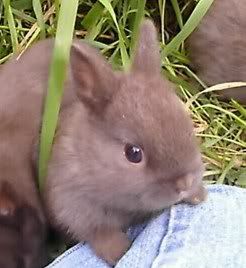Runny / Weepy Eyes, Eye Spots, Infections … There’s a lot to learn.
by Laurie Stroupe.
I have a story to tell you about an eye spot. It’s just one story, so take it for what it’s worth and add it to everything else you learn about eye spots.
The truth is, we just don’t know enough about them. I think that when we are limited in actual knowledge, we tend to say it is genetic or treat the situation as if it were genetic. It’s the conservative thing to do. Especially when we see a condition in a dam and her kits, we assume that has to be genetic. But dams also have the opportunity to share infections and infestations with their young, not just their genetic material.

And even when something is genetic, we still may want to know whether it’s the vulnerability or the actual condition that is inherited. You might say at first that is splitting hairs, but would it make a difference to you if you got the best rabbit of your entire career and it just had some susceptibility versus a full-blown condition? I might be tempted to try to breed out the problem and collect up all of the good if the rabbit is not actually ill or DQ-able.
So anyway, here is my story. It starts out with me being totally dumb and then having one of those coulda-had-a-V-8 moments.
A couple of months ago, a Holland Lop of mine started having a runny eye. I treated her with Pen B but got no response, so I figured it must not be a bacterial infection. Then I decided that she was sensitive the ammonia from the build-up of manure over the winter. It took us several weeks from that point to get it all shoveled out. But when we did, it still made no difference to her.
Then I had my V-8 moment. I knew in an instant that she was developing an eye spot. I looked and she definitely had the puckers in the eyelid we associate with eye spots. I do not believe they were there when she was younger (she’s 18 months old). And, looking further, she now has a white cloudy spot in the lower half of her left eye.
I remembered an article that I read which said that it is believed that E cuniculi is responsible for at least some types of eye spots. E cuniculi can be treated with fenbendazole, according to the same article. That’s the main ingredient in Safeguard cattle wormer. I’ve had a tube in my barn for several months, but wormed last with ivermectin. So it’s been a while since any of my rabbits had been treated with fenbendazole.
So, I gave her a pea-sized portion each day. After three days, the runny eye totally cleared up!
This was amazing to me. Remember, her eye had been teary for a couple of months. Although it could be a coincidence and this is just one anecdotal report, I think there might be a connection there.
[Editor’s note: We received this great tip from a reader: “The proper regimen to fully eliminate e.cuniculi from a rabbit’s brain is 30 days at 10mg/lb SID. Treatment for less than that can result in re-recurrence. I’ve actually repeated the course in severe cases. Also liquid fenbendazole should be used so it can be accurately dosed not a “pea sized” amount of paste.”]
I wish I had had my V-8 moment earlier. I believe, though I don’t know for sure, that I could have prevented the eye spot from forming if I had treated her when the eye first started running.
If you notice a rabbit squinting, take a look for an eye spot. Now, is it that rabbits with puckers in their eyelids are more susceptible to collecting E cuniculi? Or does E cuniculi attack the eyelids and damage them which subsequently causes the scarring on the eyeball? I have no idea. If it is an infection of E cuniculi, is there still a hereditary component? Eye structure? Vulnerability to E cuniculi? Or could dams be passing down the infection to their young?
Like I said, this is just one tiny piece of information. If you try fenbendazole with runny eyes and it helps, let me know. It would be great for all of us to have yet another technique we can use to keep our herds healthy and prevent nice rabbits from developing DQs.
